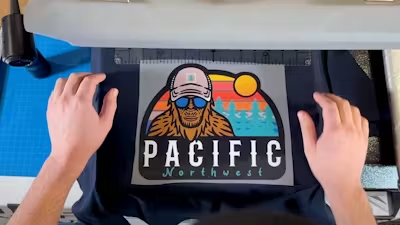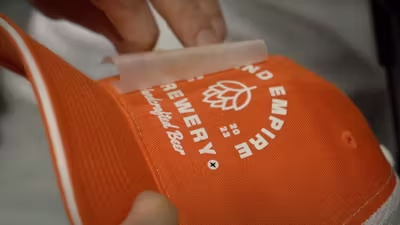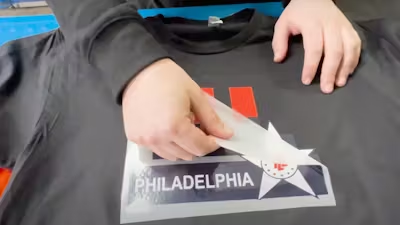Looking to avoid a plastic feel on your finished products? While DTF (Direct-to-Film) printing offers outstanding color vibrancy, crisp details, and excellent durability, some users seek ways to improve the breathability, texture, drape, and softness of their prints.
The good news is that there are several effective solutions to this challenge. This guide will walk you through practical techniques for achieving a more natural feel in your DTF-printed garments.
From design adjustments and application techniques to fabric choices and printing considerations, we cover a range of strategies that can significantly reduce that plastic sensation. This toolkit of methods will give you the knowledge to produce DTF transfers that look and feel great. Let's go.
Table of contents
- Adjusting Your Design
- Application and Garment Fabric
- Printing DTF Transfers at Home
- Managing Expectations
- Trial and Error: The Key to Success
- Mastering the Art of Soft DTF Transfers

Adjusting your design
Optimizing your design in a graphics program is the most crucial step you can take to reduce the plastic feel of your DTF transfers, especially if you're ordering pre-printed transfers. The key is to reduce the overall print coverage and break up the surface area and continuity of the design. This approach not only improves the feel of the final product but can also enhance its visual appeal.
Here are several techniques you can use to adjust your design:
Remove the background
The most basic step in optimizing your design is removing unnecessary background elements. This isn't just about deleting the area around your main design; it's about being intentional with every element you include.
- Use a transparent background instead of a solid color block. This will need to be a vector file, or if it is raster, it should be a file type that supports a transparent background (PSD or PNG)
- Eliminate any other large, solid background shapes that aren't essential to your design.
- If your design has a border, consider whether it's truly necessary, or if removing it might create a more integrated look with the garment.

Omit the shirt color
Look for areas within your design that match the color of the shirt you'll be printing on. Removing these areas can significantly reduce the amount of ink used, resulting in a softer feel.
- For dark shirt colors like charcoal or navy, you can often remove black elements from your design without significantly altering its appearance.
- When designing, consider your shirt color choices carefully. Some designs may work better on certain colors, allowing you to omit more of the design.
- Remember, the goal is to let the fabric show through where possible, creating a more breathable and flexible print.

Use halftones
Halftones are a game-changer, especially for photographic or detailed designs with gradients or blended edges that fade into the shirt color.
- Halftones break up solid areas of color into tiny dots, allowing the shirt fabric to show through.
- This technique not only creates a natural-looking fade but also improves breathability and softness.
- Halftones are particularly effective for creating smooth transitions between colors or fading an image into the background.
- For detailed instructions on using halftones, check out our comprehensive guide on using halftones in DTF printing.

Apply patterns and textures
For designs with large solid areas that can't be halftoned, consider applying patterns or textures.
- Use small dots, lines, geometric shapes, or even hand-drawn organic patterns to break up solid areas.
- Think of this technique as strategically "punching" tiny holes or lines in your design.
- You can apply patterns to your entire design or just to specific portions for a unique effect.
- While this technique may slightly reduce the overall vibrancy and solidity of the design, it's often a worthwhile trade-off for improved drape and breathability.
- Experiment with different patterns to find what works best for your style and the specific design.

Use a distress effect
Creating a distressed or vintage look can significantly reduce the plastic feel while adding character to your design.
- Distress effects make the print look naturally worn or weathered, resulting in a faded appearance.
- You can download various distress textures online or create your own custom textures if you have the skills.
- These effects can create looks ranging from slightly worn to heavily distressed, with cracked, rugged, or dirty appearances.
- Keep in mind that heavily distressed designs may result in some tiny bits that don't transfer, but this often enhances the overall worn look.
- Check out our guide for step-by-step instructions on applying special effects like distress to your DTF designs.

Application and garment fabric
While design adjustments play a crucial role in reducing the plastic feel of DTF transfers, there are several techniques you can employ during the application process and choices you can make regarding the garment fabric that can further enhance the softness and texture of your final product.
Press a second time
After your initial press and peel, consider applying a second press to your transfer. A second press can give the print a matte finish, reducing the shine that often contributes to the plastic feel. This technique helps the ink settle into the fabric fibers more effectively, resulting in a softer hand feel.
Use a textured guard sheet
Incorporating a textured guard sheet during the pressing process reduces shine and can significantly impact the feel of your final print. Polytetrafluoroethylene (PTFE) sheets are commonly used and available in different textures. In some cases, you can use textured paper or other types of sheets as long as they can withstand the heat without burning.
Choose a textured garment
The texture of the garment itself can significantly affect how the DTF transfer feels. While many blank apparel options for printing strive for a smooth surface, consider using fabrics with more texture, such as pique cotton. Heavier cotton fabrics and certain blends tend to have a more textured surface compared to premium ringspun cotton or polyester. Keep in mind that textured fabrics may affect the design details.
Choose a heavier fabric weight
The weight of the fabric can influence how prominent the DTF print feels on the garment. Lighter-weight fabrics (such as 3-4 oz and tri-blends) tend to make the print more noticeable. Heavier-weight fabrics (5-6 oz, sweatshirts, etc.) are often more forgiving because the weight of the print is relatively lighter compared to the fabric.

Printing DTF transfers yourself
For those who print their own DTF films, additional factors can significantly impact the feel of the final product. While we can't go too deep into DTF printing here, we outline some key areas to focus on. For more in-depth advice, we recommend consulting with printer manufacturers and suppliers. If you order your DTF transfers by size from us, you don't have to worry about any of this.
- Optimizing underbase thickness: Experiment with reducing the white underbase thickness, potentially down to 50%. This can minimize the plastic-like feel while still providing adequate color support, especially on dark garments.
- Fine-grind powder: Consider using fine-grind hot melt adhesive powders. These tend to melt more evenly and integrate better with the fabric, resulting in a softer print.
- Quality ink and film considerations: Invest in high-quality ink, especially white ink. Pay attention to the coating on your DTF film and balance ink adhesion with flexibility for optimal results.
- Film peel: Experiment with different film types (hot, warm/cool, or cold peel) to find the right balance between easy release and a soft feel.
Finding the right combination of these factors may require trial and error. Always balance softness with durability and wash-fastness, and thoroughly test your prints before offering them to customers.

Managing expectations
While we've explored numerous techniques to reduce the plastic feel of DTF transfers, it's crucial to understand and communicate the inherent limitations of the DTF printing process:
- Every printing method has its unique characteristics, and DTF is no exception. It's important to educate your customers about what to expect from DTF prints.
- While DTF offers excellent color vibrancy and durability, achieving a feel identical to the bare fabric may not always be possible.
- Highlight DTF's benefits, such as its ability to produce detailed, full-color designs on various fabric types.
- Be transparent about the slight texture difference they might feel compared to screen printing or other methods.
- Emphasize that the techniques we've discussed can significantly improve the comfort and breathability of the prints.
Trial and error: The key to success
For most professionals in the custom apparel industry, success comes through experimentation and refinement:
- Don't be afraid to try various combinations of the techniques we've shared here.
- Remember that different designs may require different approaches. What works best can vary depending on your specific equipment, materials, designs, and target market.
- Keep detailed records of your experiments, noting design adjustments made, application techniques used, fabric choices, printing parameters (for those printing at home), and results observed, both immediately after printing and after washing.
- Be patient with the process. Perfecting your technique may take time, but the results are worth it.
- Engage with your customers and gather feedback. Their input can be invaluable in refining your approach.
- Have fun with the process. Creative problem-solving is part of what makes the custom apparel business exciting.

Mastering the art of soft DTF transfers
Reducing the plastic feel of DTF transfers is an art that combines creativity, technical know-how, and a willingness to experiment. Optimize your designs, experiment with application techniques, choose garments wisely, and fine-tune your printing process if you're doing it at home. Remember to manage customer expectations while highlighting DTF's unique benefits, and don't shy away from the trial-and-error process to find what works best for your specific needs.
We're committed to providing you with top-quality DTF transfers that offer both visual impact and comfort. We also help optimize your art files for the best possible results. For high-quality blank apparel to pair with your transfers, check out Ninja Blanks, your go-to source for premium garments.
Here's to your success in creating custom apparel that your customers will love to wear!








































